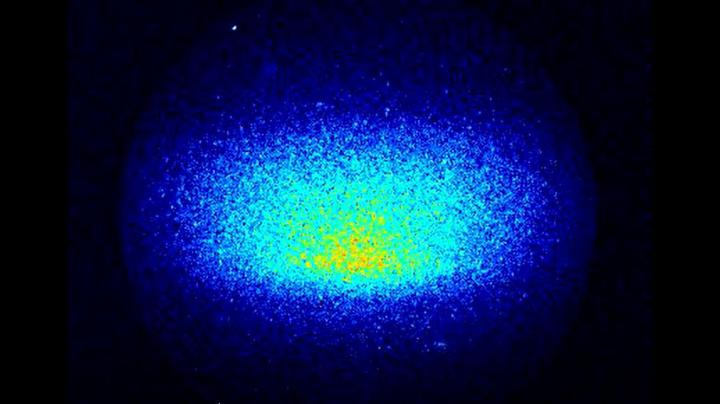Using lasers to visualize molecular mysteries in our atmosphere

Molecular interactions between gases and liquids underpin much of our lives, but difficulties in measuring gas-liquid collisions have so far prevented the fundamental exploration of these processes. Researchers in the U.K. hope their new technique of enabling the visualization of gas molecules bouncing off a liquid surface will help climate scientists improve their predictive atmospheric models. The technique is described in The Journal of Chemical Physics. This image shows a packet of hydroxyl radical molecules hitting a liquid surface and creating a broad scattered plume, which is nearly identical for the two angles of approach, vertically or at 45 degrees. Credit: Kenneth McKendrick
Invisible to the human eye, molecular interactions between gases and liquids underpin much of our lives, including the absorption of oxygen molecules into our lungs, many industrial processes and the conversion of organic compounds within our atmosphere.
But difficulties in measuring gas-liquid collisions have so far prevented the fundamental exploration of these processes.
Kenneth McKendrick and Matthew Costen, both at Heriot-Watt University, in Edinburgh, U.K., hope their new technique of enabling the visualization of gas molecules bouncing off a liquid surface will help climate scientists improve their predictive atmospheric models. The technique is described in The Journal of Chemical Physics, from AIP Publishing.
“The molecule of interest in our study, the hydroxyl radical, is an unstable fragment of a molecule that affects the whole of the understanding of atmospheric chemistry and things that genuinely affect climate,” said McKendrick.
“Some of these important OH reactions take place at the surface of liquid droplets, but we can't see surface interactions directly, so we measure the characteristics of the scattered molecules from real-time movies to infer what happened during their encounter with the liquid.”
Laser sheets are the key to the technique, inducing a short-lived fluorescent signal from each molecule as it passes through 10 nanosecond pulses. Laser-induced fluorescence isn't new in itself, but this was the first time laser sheets have been applied to scattering from a surface in a vacuum with no other molecules present to interfere with the scattering from the molecular beam.
This enabled the McKendrick team to capture individual frames of molecular movement, from molecular beam to liquid surface and scattering, which were compiled into movies.
Unlike previous methods of capturing gas-liquid interactions, all the characteristics needed to understand the interaction — speed, scatter angle, rotation, etc. — are captured within the simple movies that McKendrick describes as “intuitive.”
By observing the molecular film strips, McKendrick's team noted molecules scattered at a broad range of angles, similar to a ball bouncing off in all directions when thrown onto an uneven surface. This simple observation directly proved the surface of liquids is not flat.
“When you get down to the molecular level, the surface of these liquids is very rough, so much so that you can barely tell the difference between the distribution of molecules when directed down vertically onto the surface or when at an angle of 45 degrees. This finding is important for understanding the chances of different molecular processes happening at the liquid surface,” said McKendrick.
As they improve their technique, McKendrick's team hopes to collect more refined information from atmospheric relevant liquids. But McKendrick points out the technique is not limited to the field of atmospheric science and is likely to soon be applied to understanding the gas-solid interactions that occur in processes such as the catalytic conversion of gases in car engines.
###
The article, “Real-space laser-induced fluorescence imaging applied to gas-liquid interfacial scattering,” is authored by Robert H. Bianchini, Maksymilian J. Roman, Matthew L. Costen and Kenneth G. McKendrick. The article will appear in The Journal of Chemical Physics on August 6, 2019 (DOI: 10.1063/1.5110517). After that date, it can be accessed at http://aip.
ABOUT THE JOURNAL
The Journal of Chemical Physics publishes concise and definitive reports of significant research in the methods and applications of chemical physics. See http://jcp.
Media Contact
More Information:
http://dx.doi.org/10.1063/1.5110517All latest news from the category: Physics and Astronomy
This area deals with the fundamental laws and building blocks of nature and how they interact, the properties and the behavior of matter, and research into space and time and their structures.
innovations-report provides in-depth reports and articles on subjects such as astrophysics, laser technologies, nuclear, quantum, particle and solid-state physics, nanotechnologies, planetary research and findings (Mars, Venus) and developments related to the Hubble Telescope.
Newest articles

NASA: Mystery of life’s handedness deepens
The mystery of why life uses molecules with specific orientations has deepened with a NASA-funded discovery that RNA — a key molecule thought to have potentially held the instructions for…

What are the effects of historic lithium mining on water quality?
Study reveals low levels of common contaminants but high levels of other elements in waters associated with an abandoned lithium mine. Lithium ore and mining waste from a historic lithium…

Quantum-inspired design boosts efficiency of heat-to-electricity conversion
Rice engineers take unconventional route to improving thermophotovoltaic systems. Researchers at Rice University have found a new way to improve a key element of thermophotovoltaic (TPV) systems, which convert heat…



